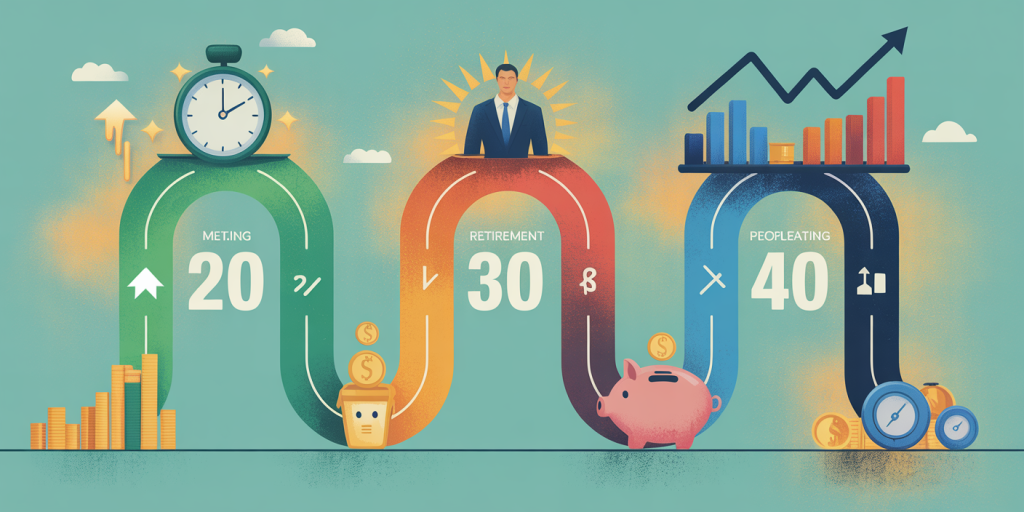Investing Mistakes to Avoid in Your 20s, 30s, and 40s
Investing is a crucial component of building long-term wealth and financial security. However, the approach and challenges differ significantly as you age. Your 20s, 30s, and 40s represent distinct phases in your financial journey, each requiring tailored investment strategies. Making mistakes during these decades can have long-lasting effects on your financial future. Avoiding common pitfalls will empower you to maximize returns, minimize risks, and build a robust portfolio that grows with your evolving life goals.
This article outlines the key investing mistakes to avoid at each stage, backed by real-world examples, data, and strategic insights. By understanding the unique challenges and opportunities inherent to each decade, you can optimize your approach, set realistic expectations, and safeguard your financial well-being.
Investing Mistakes to Avoid in Your 20s: Missing Out on Time and Risk
Your 20s represent one of the most advantageous times to invest due to the power of compounding and relatively high risk tolerance. Unfortunately, many young investors fail to capitalize on this potential because they lack financial education or patience.
One common mistake in your 20s is not starting early enough. According to a study by Vanguard, starting to invest $200 per month at age 25 can accumulate nearly $500,000 by age 65 at an 8% return, whereas delaying until 35 yields less than half that amount for the same monthly investment. This stark difference highlights how valuable starting early is, as even small amounts can snowball given enough time. For example, a 25-year-old investing in broad index funds benefits from decades of market growth, while a 35-year-old loses a critical 10 years of compounding.
Another typical blunder is excessive risk aversion or conversely, chasing speculative trends. Many young investors oscillate between being overly cautious, missing growth opportunities in equities, or falling prey to “hot” stocks and crypto hype without a clear strategy. A practical case to consider is the rollercoaster of Bitcoin’s price in the late 2010s and early 2020s. Some 20-something investors who put a disproportionate amount of their portfolios into crypto faced severe portfolio volatility and losses during downturns. A balanced, diversified portfolio combining equities, bonds, and alternative assets is advised to mitigate risks and achieve steady growth.

Common Pitfalls in Your 30s: Ignoring Retirement Planning and Overleveraging
Entering your 30s often means increased expenses, such as homeownership and family responsibilities, which can constrain investment budgets. However, neglecting long-term planning during this phase can hinder financial independence down the line.
A critical mistake in the 30s is underestimating the importance of retirement savings. According to Fidelity Investments, the average 30-year-old has approximately $41,000 saved for retirement in 2023, which falls short compared to the target of $105,000 for that age group. Many delay maximizing contributions to 401(k)s or IRAs due to competing priorities, which narrows the window for compounded growth. Real-world cases reveal individuals who started aggressively saving in their 30s often achieve more substantial nest eggs than those who waited until their 40s to increase contributions.
Additionally, overleverage—taking on excessive debt in pursuit of quick investment gains—poses significant risks. Leveraged investing magnifies both gains and losses, and many 30-somethings overconfident in their financial stability may undertake margin trading or risky real estate flips. For example, during the 2008 financial crisis, numerous individuals in their 30s who invested heavily in real estate with borrowed capital faced severe financial distress when markets crashed and liquidity dried up. Maintaining a conservative debt-to-investment ratio and focusing on building equity organically is critical during this decade.
Mistakes to Avoid in Your 40s: Failing to Rebalance and Not Adjusting Risk Profile
By your 40s, the horizon to retirement begins to shorten, demanding more strategic investment decisions. Yet, procrastination in portfolio adjustments or clinging to aggressive early-stage risk-taking can jeopardize future financial stability.
One prevalent mistake is failing to rebalance the portfolio periodically. Typically, investors start heavily weighted in equities for growth in their earlier years. In their 40s, maintaining the same allocation can expose them to unnecessary volatility while they may need to preserve capital. A study by Charles Schwab suggests that regular rebalancing can enhance portfolio returns by about 0.5% annually over long periods while reducing risk. Without rebalancing, some 40-year-olds reported significant drawdowns during market downturns in 2020 that could have been lessened by adjusting asset allocations to safer bonds or dividend-paying stocks.
Another key error is neglecting to adjust the risk profile as retirement nears. Continuing to pursue high-risk growth investments without reallocating to safer assets like bonds, treasuries, or annuities can expose your portfolio to sharp erosion during a market correction. For instance, following the dot-com bubble burst in the early 2000s, many investors in their 40s who kept a heavy tech stock concentration lost critical capital that set back their retirement timeline. Starting in your 40s, shifting gradually toward capital preservation while seeking moderate growth is the recommended approach.

Comparative Table: Investing Mistakes Across Decades
| Age Group | Key Investing Mistakes | Real-World Example | Recommended Strategy |
|---|---|---|---|
| 20s | 1. Not starting early | Losing decades of compounding wealth | Begin with low-cost index funds; prioritize time in market |
| 2. Chasing high-risk speculative trends | Crypto market volatility | Diversify and adopt balanced risk profile | |
| 30s | 1. Neglecting retirement contributions | Low savings compared to targets | Maximize 401(k)/IRA contributions |
| 2. Overleveraging and margin trading | Real estate crash 2008 | Control debt levels; focus on organic growth | |
| 40s | 1. Failing to rebalance portfolio | Large drawdowns during 2020 market fall | Regular portfolio rebalancing |
| 2. Not adjusting risk profile toward preservation | Dot-com bubble losses | Shift gradually to bonds, dividend stocks |
Emphasizing Education and Emotional Discipline
Regardless of your age, a fundamental investing mistake is failing to educate yourself continuously. Markets evolve, financial products change, and new investment vehicles emerge regularly. According to a 2022 Gallup survey, only 34% of Americans reported feeling knowledgeable about investing basics. Financial literacy is a cornerstone of successful investing and helps avoid panic-driven decisions.
Emotional discipline ranks equally important. During downturns, fear can trigger detrimental selling of investments at a loss, while greed during market highs can entice reckless buying. An iconic example is the 2007–2009 Great Recession where many average investors liquidated their stock holdings near the market bottom. Meanwhile, those who held steady or bought more assets during declines witnessed rebound advantages. Techniques like setting stop-loss orders, following predetermined rebalancing rules, or consulting a financial advisor can help maintain discipline and minimize emotional bias.

The Future of Investing: Adapting to Changing Landscapes
Looking forward, investing strategies must consider broader trends such as technological innovation, environmental, social, and governance (ESG) integration, and inflationary pressures. Younger investors increasingly prefer sustainable investing, which can offer both financial returns and social impact. Data from Morningstar shows that ESG funds attracted over $51 billion in net flows during 2023 alone, illustrating shifting investor preferences.
Additionally, advancements in fintech and robo-advisors simplify portfolio management across age groups, allowing for tailored asset allocation and automatic rebalancing. This technology-driven personalization helps investors avoid common mistakes by adhering to disciplined strategies aligned with individual goals and risk tolerance.
Finally, with inflation rates trending upward globally—averaging around 3.4% in 2023 as per the IMF—investors in every age category need to prioritize asset classes that hedge against inflation, such as real estate, commodities, and inflation-protected securities.
In conclusion, investment mistakes vary with age but share underlying themes of timing, risk management, education, and adapting to evolving market conditions. Recognizing these age-specific mistakes enables investors to craft better strategies, enhance portfolio resilience, and ultimately achieve their financial objectives.
